sometimes it feels like I shift into alternate universes. Here’s one where a Nynex ad for call waiting coexists with a Kindle. We’re all connected, eh?

Blogging since 2002
Exhibit A: Neo dodging bullets
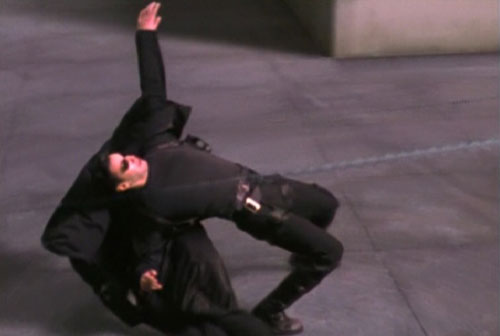
Exhibit B: Member of the New York City Float Committee dance group
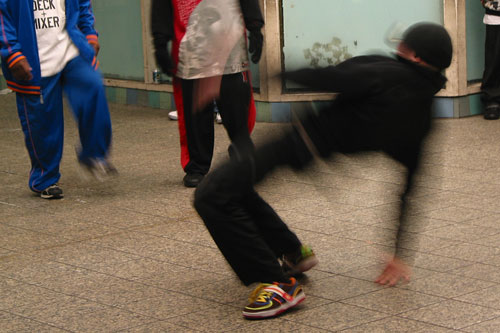
Time is slowly erasing the traumatic memory of the two world wars. That is to say that the people who fought in it are dying out, and the younger generations do not like to think of the horrors that the two great wars brought.
When I was growing up, World War II did not seem very exciting to me, from the infantile militarism standpoint. Bootleg American movies, like Rambo and Star Wars seemed oh so much cooler. WWII killing machines seemed outdated and andand reminiscences of veterans who were invited into Soviet classrooms prior to every May 9th – boring.
I did like the Polish movie serial about WWII, called “Four tankers and dog” (“Четыре танкиÑта и Ñобака” in Russian and “Czterej pancerni i pies” in Polish). It was an awesome, awesome serial about a Polish tank’s crew in WWII. Recently I purchased it on DVD from a Russian movie store as a present for my childhood friend. We watched it a bit, and I’ve got to tell you, it held up amazingly well.
Later, I realized that “Star Wars” technology was based on WWII, down to space battles mimicking real aerial dogfights. The rest of ideas Lucas lifted from Kurosawa’s The Hidden Fortress. That was probably one of the reasons why the original 3 episodes were so much cooler then the new ones.
WWII is all the rage these days. You can’t swing a dead cat without hitting an awesome WWII game. Mike Mingola brought back WWII chic in his Hellboy comics, Nazi mad scientist and all.
I particularly like WWII-style superheroes, without overabundance of superpowers and in baggy costumes with many gear pockets and bandoliers. In Hellboy’s origin story, there’s a panel where a group of Allied soldiers poses for a picture with Hellboy and Liberty Torch, a wartime superhero, that appeals to me a lot. I also liked how in Batman: Year One Batman uses thermite as a weapon that he gets from his military-looking bandolier belt.
For the firts time since Augusta Ada King, Countess of Lovelace and Charles Babbage, computer programmers became active, this time being driven not by intellectual curiosity, but by a dire need to break Nazi codes. If not for the Polish scientists who created the first Enigma-breaking mechanical “bombes”, Alan Turing and the rest of the computer pioneers, me and my dad not only wouldn’t be computer programmers, but probably would not have been born.
That reminded of an echo of WWII that I once encountered. I used to work as a doorman, porter and elevator operator in an Upper West Side residential building where Robert Oppenheimer was born. There was a very nice old man who lived alone in a huge pre-war apartment. Every year he asked one of the staff to help him set all the clocks in the apartment during the daylight savings switch. It remains one of the more memorable experiences for me from my employment there. I remember a huge apartment with many clocks. The old guy seemed to be very anxious to have all of them set, and all of them set correctly, asking me several times to check and doublecheck. Must have taken me half an hour to get them all. Once I set all the clocks he became very relieved.
I guess the guy had a very special relationship with time. My boss told me he saw a number tattoo on the old man’s arm. That most likely means that he had a “user id” for an IBM punchcard machine in Auschwitz.
I’ve been pretty busy the last couple of days and did not get my fill of TV. The day before yesterday I had a dream in which I was working on some bikes with Paul Teutul Sr. Today’s dream involved me working for detective Monk, I think, while investigating Tony Soprano and his associates. Paulie Walnuts had a blood stained shirt from someone he murdered hanging above his bed, he wanted to hide it, but was too lazy to do so.
1986. Mir Space Station is launched. Space Shuttle Challenger explodes. Nintendo releases The Legend of Zelda. Mary-Kate and Ashley Olsen are born, as well as one of the London Underground suicide bombers.
Odessa, Soviet Union. Public School #39 (former Madame Balen De Balu’s Gymnasium for Girls), 3rd grade, group A poses for a picture in front of a patriotic mural depicting the fictional underage foe of burgouise, Malchish Kibalchish. Here’s a modern rendering. If I remember correctly, the remainder of the mural depicted Malchish’s main foe, Main Burjuin and his henchmen. I might be wrong about that though.
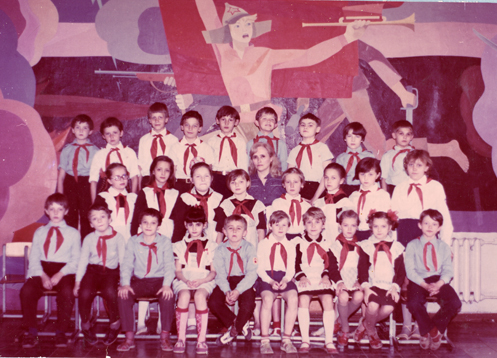
Somehow I missed school the day when the picture was taken. Of all the people in the picture, I sometimes chat on ICQ with two.
Update:
An interesting thing to notice is the color of boy’s shirts. There were two types of uniforms – one for special occasions and one for everyday use. No doubt that prior to the picture was taken everyone was told to put the special occasion uniform, which for boys means white shirts instead of blue ones, and for girls – white aprons instead of brown or black ones (like seen in this ebay auction). As you can see, all the girls are wearing white aprons, but most of the boys are wearing incorrect blue shirts.
And here’s what I spent much of my Sunday sitting in the armchair and reading The Amazing Adventures of Kavalier & Clay (thanks for recommendation, badger). For a minute I thought about where all the stuff that surrounded me was made.
Matcha tea is from Kyoto Japan, so is the bowl. The cigar’s components hail from Nikaragua, Ecuadore and Sumatra. The water is from Fiji. The ashtray is probably made in China (my radium glass ashtray broke) and so is the window fan that sucks out all the smoke. The armchair is made in Italy. Tilde the cat is probably made in Brooklyn (even though she looks sullen, she was not posed at all).

I wonder if Michael Chabon got the name for one of the title characters from this old hotel a couple of block from the Empire State Building.
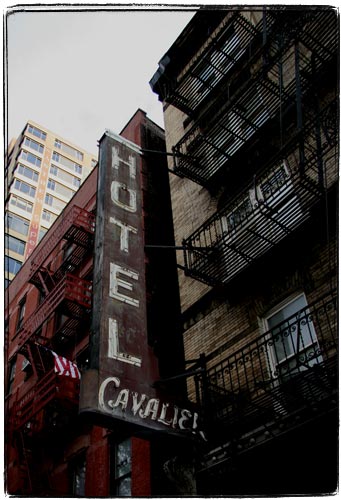
Hi, Prime Minister Timoshenko? Yeah, Senator Organa called, she wants her hair back.
And all we get is a crummy Palpatine-looking Senator.
I wonder if Oleksandr Tymoshenko have seen that “Friends” episode…..
Setting Wright’s book aside, I went on to read Jack Finney’s “Time And Again” which was up next. I’ve read it in Russian translation many years ago, but understood very little of what makes it so very special a book. My mom seemed to appreciate it better back then, because it remains the only science fiction book that she ever liked. This time, in English and after a quarter of my lifetime spent in New York, the book truly resonated.
“Time And Again” is a time travel story, with a novel and decidedly low tech approach. The idea is that the past really exists, but we do not slip back into it because our minds are tethered to the present by a web of knowledge that is increasingly time specific: computer is a machine, not a person; Microsoft is a giant corporation,not a tiny little startup; Altavista is forgotten, Google is the best search engine; webpages are out, blogs are in; I just opened Semagic to write this post, I just typed this sentence. We are constantly reminded of when we are: our computers hum, there are airplanes flying overhead, if we look out of the window there are cars parked outside. We call them cars, not automobiles most of the time.
To travel back you need to find a places that exists both in the present and in the past unchanged, potential portals. If have certain talents, go to such a place, dress in the style of the past, eat what people used to eat then, become saturated with the lingering atmosphere of the past. And then, trough self hypnosis, make yourself temporarily forget about modern things – and back you go, into the past.
In the book, a government secret project taps a talented, but loosely and dissatisfied illustrator Si Morley who successfully uses an empty apartment in the Dakota Building near Central Park to travel back to the Eighties. The Eighteen Eighties.
Just like Jack Finney is better known for “Invasion of The Body Snatchers“, the Dakota is better known as the building where John Lennon lived and inf front of which he was killed. It’s a monster of a building with 14 ft ceilings, very thick walls and giant apartments. From the top floors all you can see is Central Park, a place that is kept true to Frederick Law Olmsted’s master plan as much as possible. In short – a time portal.
What I especially love about the book is the fact that it is very well illustrated with photographs and drawings which are presented by the protagonist in line with the narration. Why in this age of computer augmented publishing so few other books show photographs next to the text that describes them is beyond me.
Here’s Si Morley’s photo of the Dakota side to side with my version:
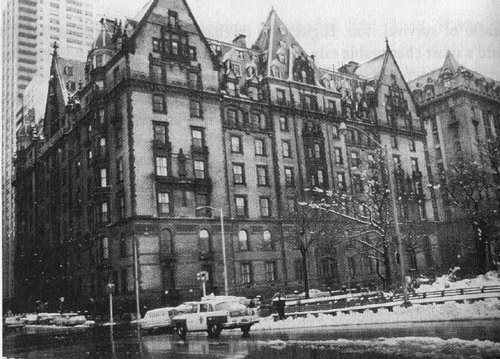
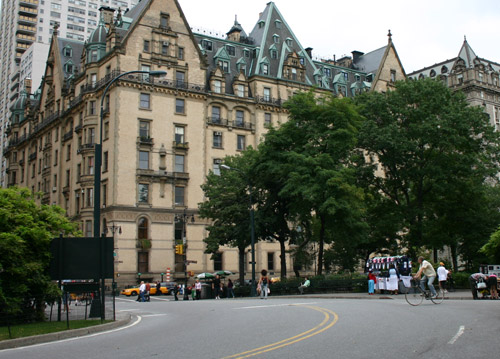
I knew about the Batman Building of Nashville, TN, but recently I found one right here, in Manhattan:
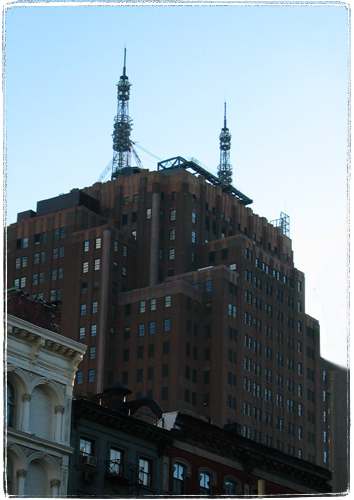
I have no idea what it’s called.
Update: it’s one of the numerous AT&T buildings.
The governor of California must have asked our mayor to strategically place containers of liquid nitrogen to fight of devious Fox Mulder replacing T-1000 Terminators.
Here’s a whole unguarded truck:

And here’s a fine example of ducttapemanship:
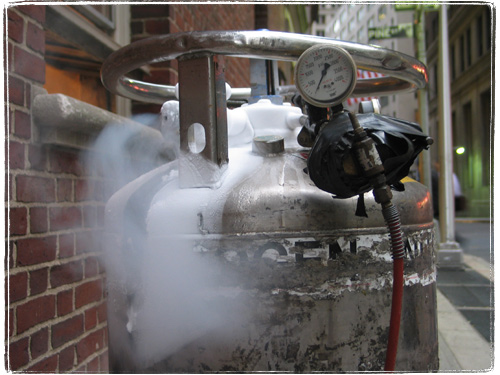
I wrote about the NYC LN2 phenomenon earlier.